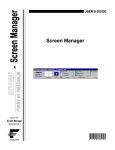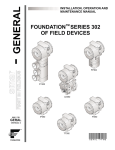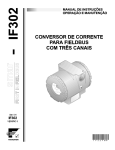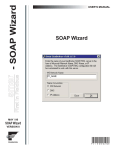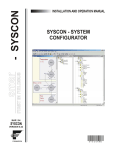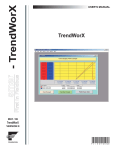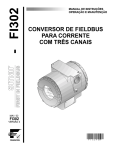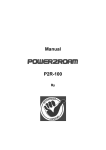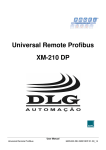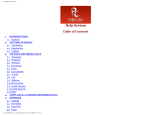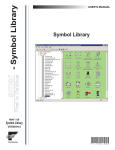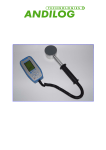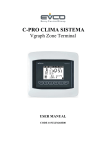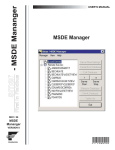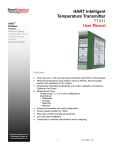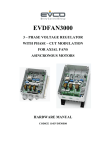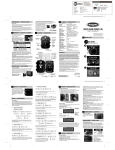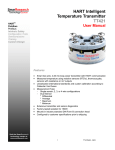Download JUNE / 02 VERSION 6
Transcript
JUNE / 02 VERSION 6 FOUNDATION P V I E WS M G M E smar web: www.smar.com e-mail: [email protected] Specifications and information are subject to change without notice. BRAZIL Smar Equipamentos Ind. Ltda. Rua Dr. Antonio Furlan Jr., 1028 Sertãozinho - SP 14170-480 Tel.: +55 16 645-6455 Fax: +55 16 645-6450 e-mail: [email protected] ARGENTINA Smar Argentina Soldado de La Independencia, 1259 (1429) Capital Federal – Argentina Telefax: 00 (5411) 4776-1300 / 3131 e-mail: [email protected] CHINA Smar China Corp. 3 Baishiqiao Road, Suite 30233 Beijing 100873, P.R.C. Tel.: +86 10 6849-8643 Fax: +86-10-6894-0898 e-mail: [email protected] GERMANY Smar GmbH Rheingaustrasse 9 55545 Bad Kreuznach Germany Tel: + 49 671-794680 Fax: + 49 671-7946829 e-mail: [email protected] MEXICO Smar México Cerro de las Campanas #3 desp 119 Col. San Andrés Atenco Tlalnepantla Edo. Del Méx - C.P. 54040 Tel.: +53 78 46 00 al 02 Fax: +53 78 46 03 e-mail: [email protected] SINGAPORE Smar Singapore Pte. Ltd. 315 Outram Road #06-07, Tan Boon Liat Building Singapore 169074 Tel.: +65 6324-0182 Fax: +65 6324-0183 e-mail: [email protected] USA Smar International Corporation 6001 Stonington Street, Suite 100 Houston, TX 77040 Tel.: +1 713 849-2021 Fax: +1 713 849-2022 e-mail: [email protected] Smar Laboratories Corporation 10960 Millridge North, Suite 107 Houston, TX 77070 Tel.: +1 281 807-1501 Fax: +1 281 807-1506 e-mail: [email protected] Smar Research Corporation 4250 Veterans Memorial Hwy. Suite 156 Holbrook , NY 11741 Tel: +1-631-737-3111 Fax: +1-631-737-3892 e-mail: [email protected] FRANCE Smar France S. A. R. L. 42, rue du Pavé des Gardes F-92370 Chaville Tel.: +33 1 41 15-0220 Fax: +33 1 41 15-0219 e-mail: [email protected] Index Contents Getting Started ......................................................................................................................1 Purpose of the Screen Manager ......................................................................................................................1 Launching the Screen Manager ................................................................................................................1 User Interface ............................................................................................................................................3 Functional Description ...............................................................................................................................3 Thumbnail Window..............................................................................................................................3 Layouts List .........................................................................................................................................4 History List ..........................................................................................................................................4 Applications List ..................................................................................................................................4 Save Layout button .............................................................................................................................5 Logon Button.......................................................................................................................................5 Command Bar Menu Items........................................................................................................................5 Project Launching Options ........................................................................................................................6 Program Group or Project Shortcut ...........................................................................................................6 Controlling the Screen Manager via command line...................................................................................6 Launching a Layout.............................................................................................................................7 Launching an application within a layout ............................................................................................7 Creating and Modifying Layouts ......................................................................................................................8 Modifying Application Launch Properties ..................................................................................................8 Selecting a template or existing layout......................................................................................................9 Dragging Applications into a panel ............................................................................................................9 Panel Properties ......................................................................................................................................10 Customization of Project using Project Startup Dialog............................................................................12 III Screen Manager - User’s Manual IV Getting Started Getting Started Purpose of the Screen Manager The purpose of the Screen Manager is to provide the user with the ability to manage his/her screen space on single or multiple monitors by selecting pre-defined screen layouts. These screen layouts can: • Manage the screen space. • Provide the ability to load combinations of pre-configured applications. Launching the Screen Manager The Command Bar is a dialog-based application, which can be launched via a Project Icon, Program Group or from Windows Explorer. From the Start Menu, select Programs, System302, ProcessView, and click on the Screen Manager icon on the Tools group. Figure 1 - Launching Screen Manager from the Start Menu The Screen Manager Command Bar – Project Information dialog displays as shown below: 1 Screen Manager - User’s Manual Figure 2 - Screen Manager Command Bar - Project Information Specify the Project directory and the initial screen layout file to be used. The Browse button can be used to search for valid screen layout (.pwf) files as shown below: Note: At least one .pwf layout file must exist in the directory. Figure 3 - Locate PWF Layout Files Dialog Select the layout file and click OK. The Screen Manager Command Bar will appear as shown in below. To select a new layout, doubleclick on any layout shown in the Layouts List or History List. Figure 4 - Screen Manager Command Bar 2 Getting Started User Interface The Screen Manager Command Bar runs locally on each user station. The Command Bar is a dialog-based application, which can be launched via a Project icon, Program Group or from File Explorer. Functional Description The Screen Manager Command Bar shown in the following figure allows the user to interact with the desktop layout. It provides the ability to treat several applications as one desktop display. The combination of the Configuration and Runtime portions of the screen manager provides the functional support for: • Controlling application window desktop location. • Window style properties. • Window launch properties. • Changing displays. • Providing access to available application. • Providing security for user actions. Figure 5 - Screen Manager Command Bar Only one Screen Manager Command Bar can be run on a station at a time. The command bar consists of a Thumbnail bitmap, Logon button, three list boxes and a File Save button as shown in the figure above. Thumbnail Window The thumbnail Window at the left of the dialog appears as a bitmap, which reflects the current panel layout. The thumbnail visually identifies the placement of each panel and will color code empty panels as white and populated panels as cyan. Clicking the diskette icon displays the Save As dialog box. You can use this to save the current panel layout, which will then be included in the Layouts list box. 3 Screen Manager - User’s Manual If the user left-clicks within the thumbnail, the current displays will realign to their original positions and contents. If the user right-clicks within the thumbnail, the individual panel properties can be modified as described in the section Creating and Modifying Layouts. Layouts List The Layouts List includes all layouts and template (empty layout) files found in the current project directory. To launch a layout or template, simply highlight and double-click the layout. History List The History List control box maintains a list of previously viewed layouts using the large icon of the layout. Every time a user launches a configured layout or template, it is added to this History List. Layouts can be launched from within this list via a double-click. Applications List Every project directory defines a certain collection of available application files such as GraphWorX, TrendWorX or Excel, which the user can drag and drop into available panels. The Applications List control box provides the mechanism to browse the available files. To select a data file, double-click on the application icon. This will update the list box with all data files associated with the application. The user can modify the Application Launch properties by rightclicking on the application icon which will display the Application Launch Properties dialog box described in the section Creating and Modifying Layouts. Once in Select Panel mode (achieved by right-clicking on the thumbnail on the Command Bar), the user can modify the panel properties using the Panel Properties dialog box (displayed by a left-click 4 Getting Started on the panel to be modified) discussed in the Creating and Modifying Layouts section of this help file. Save Layout button The current desktop layout or template can be saved at any time as a new layout .pwf file by clicking the diskette at the bottom of the Layouts List box. Templates should be marked read-only so that they cannot be overwritten. Logon Button The Logon button is used to launch the ProcessView Security Server and allows the user to log in. Upon logging in, the user’s actions are limited to those configured in the Security Server. Please reference the Security Server documentation for further details. Command Bar Menu Items The Screen Manager Commands is accessible using a pop-up menu. Right-clicking on the Command Bar or by right-clicking on the Command Bar title bar and selecting “Commands” launches the pop-up menu. Shutdown: is used to close the current layout and exit Screen Manager. Project Startup: is used to launch the Project Startup dialog. Minimize View: is used to minimize the Command Bar as well as all applications running in the current layout. 5 Screen Manager - User’s Manual Restore View: is used to restore the Command Bar and all applications in the current layout. Help: is used to launch online help for the Command Bar. Cancel: returns control back to the Command Bar. Project Launching Options There are two methods that can be used: Program Group or Project Shortcut Specify the project directory to be used in the box provided. Note: At least one .pwf layout file must exist in the directory. You may specify the layout file to be launched in the dialog shown below: Figure 6 - Screen Manager Command bar Project Information Click the Browse button. This displays the Locate .pwf Layout Files dialog box that allows you to choose the initial layout file to be used as default. Controlling the Screen Manager via command line The Screen Manager can be launched and controlled via a command line: ScrMgrBar.exe [“C:\Project files\Layout One.PWF”] 6 Getting Started Launching a Layout Possible specifications are: Project directory only – command bar will load with specified directory. Layout file only – command bar will launch with previous project directory. Both project directory and layout file – will launch as specified. No project directory or layout file – will launch command bar with previous project directory. ScrMgrBar.exe [/Quit or/Exit] - will close the current Screen Manager layout and exit. Note: The Screen Manager Command Bar is a single instance application. If the command line is used to launch a layout while a layout is already loaded the original layout will be closed and the new layout will be loaded. This allows other applications or scripts to control layouts of the Screen Manager. Launching an application within a layout If Screen Manager is already running with a Layout or Template, it is possible to load an application within a panel using the following syntax: ScrMgrBar.exe “c:\application_path\application_file.ext[,command_line_switch[,Panel_ Number[,Panel_Priority]]]” Some examples: ScrMgrBar.exe "Display2.gdf" would load the GraphWorx32 display (in configuration mode) into the last panel of the current layout or template. ScrMgrBar.exe "Display2.gdf,-runtime" would load the GraphWorx32 display (in runtime mode) into the first empty panel of the current layout or template. ScrMgrBar.exe "Display2.gdf,-runtime,1" would load the GraphWorx32 display (in runtime mode) into panel number one of the current layout or template. ScrMgrBar.exe "Display2.gdf,-runtime,1,1" would load the GraphWorx32 display (in runtime mode) into panel number one of the current layout or template at the highest priority. ScrMgrBar.exe "c:\my documents\Message.txt,,3" would load the message file into panel three of the current layout or template. No spaces should exist between comma separated fields. 7 Screen Manager - User’s Manual Creating and Modifying Layouts Modifying Application Launch Properties On the Screen Manager Command Bar, in the Applications List box, right-click on the application whose Launch Properties you wish to modify. This displays the dialog box shown below: Figure 7 - Screen Manager – Application Launch Properties Set the Launch Properties as described in the following table: 8 Getting Started Table: Application Launch Properties Parameters Application Name Name of the selected application. File Specification Enter File Specification information in this box to provide information about the location of a file. Clicking the button on the right lets you browse for a particular file using the Locate File Specification dialog box. If you select a specific file within that dialog to modify the default, the information is automatically entered in the File Specification box. Command Line Enter a command line to modify Application Launch Properties. Default directory Displays default directory location. Click the button on the right to browse directories using the Locate File Specification dialog box. You can set a directory in this box to modify the default. Test Click this button to test the Application Launch Properties you have just set before you finalize the changes. Click OK. Selecting a template or existing layout Select and double-click on an existing layout or a template from the Layouts List box. Once you select one of the layouts or the templates that particular layout will display in the thumbnail sketch to the left of the Layouts List box. Dragging Applications into a panel You can drag an application from the Applications List box onto a panel. If an application is already assigned to the panel, the message box shown in the figure below will display. Figure 8 - Message Box 9 Screen Manager - User’s Manual If you click “Yes,” the existing application will be replaced by the application you have selected and it will be dragged onto the panel on your desktop and launched. Panel Properties To modify the properties of any one panel, right-click on the thumbnail. This will set the system into “Select Panel” mode as shown in the following figure: Figure 9 - Screen Manager Panel Selection dialog Click on the Panel to be modified. In the Screen Manager Panel Properties dialog box, place the cursor over the panel that you wish to modify and click the mouse. The Screen Manager Panel Properties dialog box will display as shown below: Figure 10 - Screen Manager – Panel Properties dialog 10 Getting Started Define the parameters in the Panel Properties dialog box to modify the Screen Manager panel properties. The following table describes the individual parameters in this dialog: Table: Screen Manager Panel Properties Dialog Parameters Application Specifications Data file Spec Displays the location of the Data files for the application assigned to the panel. Clicking on the button at the right displays the Locate Specification Files dialog box. This allows you to browse directories for data files. Command Line Application Information being passed. Default Directory Displays the default directory for the application assigned to the panel. Clicking the button at the right lets you browse several directories to set a default directory. Test Pressing this button tests the newly modified panel layout before you click OK. 11 Screen Manager - User’s Manual Window Specifications Panel No. Displays the Panel No. for the panel selected. Panel Priority Displays the Panel priority for the panel selected. Enable Custom Window Styles Check this box to enable the Custom Window Styles section of the dialog box. Title Bar Check this box to display the Title Bar. System Menu Check this box to view the system menu for the application assigned to this panel. Minimize capability Check this box to enable the minimizing feature for the application assigned to this panel. Maximize Capability Check this box to enable the maximizing feature for the application assigned to this panel. Sizable Window Check this box to enable the resizing feature for the window. Always on Top Check this box to always display the window on top. That is, the window for the application assigned to this panel cannot be overlaid. Transparent if Empty If there is an empty panel, select whether to show placeholder application or leave empty. Disable User Input Check this box to prevent the user from entering any input. Top Enter a number to reposition and move the window for the application assigned to the panel selected. Left Enter a number to reposition and move the window for the application assigned to the panel selected. Right Enter a number to reposition and move the window for the application assigned to the panel selected. Bottom Enter a number to reposition and move the window for the application assigned to the panel selected. When you have set all the properties for this application window, click OK. Customization of Project using Project Startup Dialog Right-clicking on the Command Bar and selecting Commands / Project Startup launches the Project Startup dialog box. 12 Getting Started Figure 11 – Project Startup Dialog Box Include1 to Include100 - allows the user to browse and specify additional application data file directories for the default project directory. Include Sub Directories - forces the Screen Manager to search all subdirectories of the default project directory and include directories. Ignore File Extensions - used to identify those file extensions (separated by commas) that should not appear in the project. For example .ini, .bat, etc. Lock Command Bar Position - if checked, fixes the command bar to be either floating (default) or to be “docked” to the left, top, right or bottom edge of the primary display. 13 Screen Manager - User’s Manual 14


















